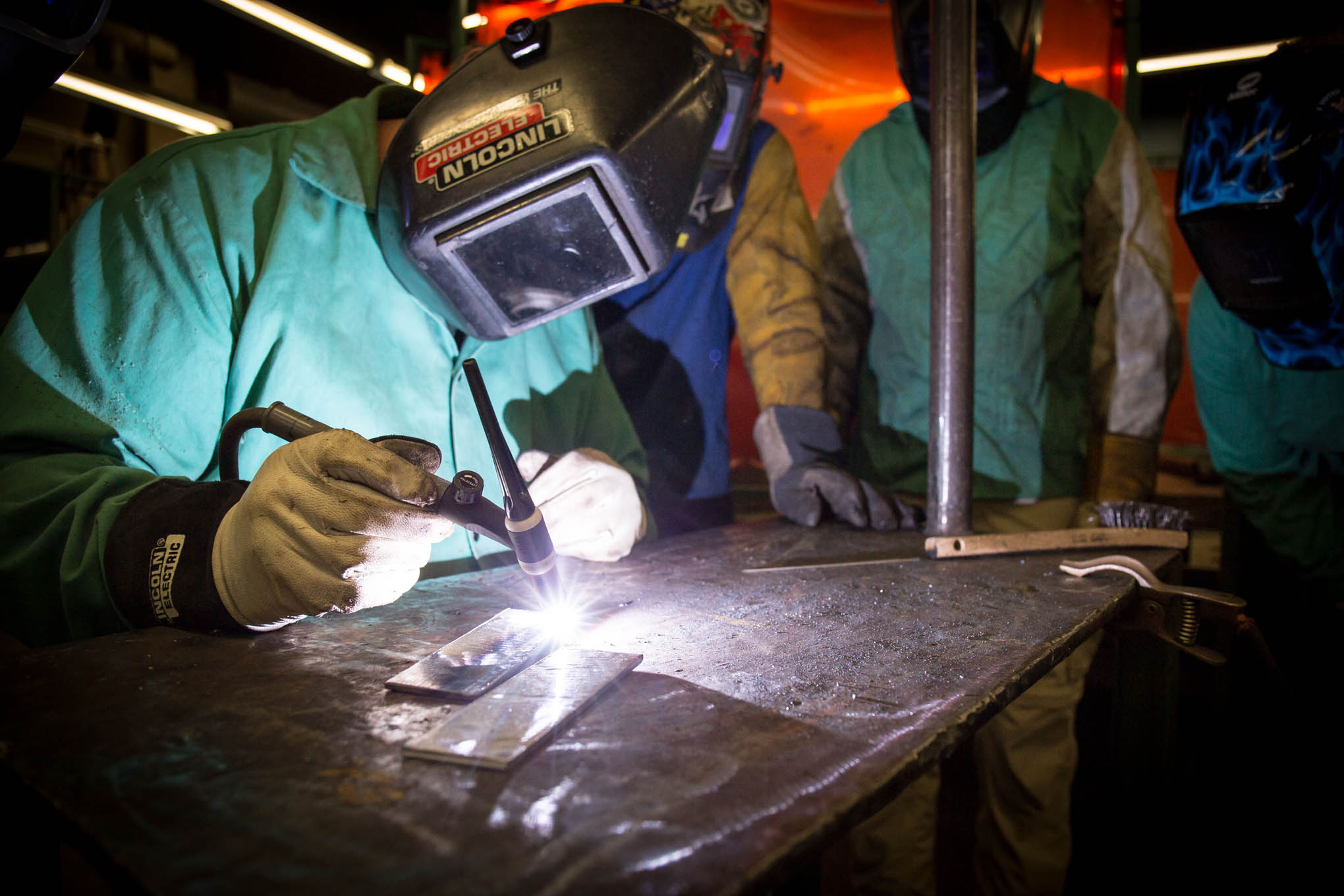College News
CCCC welding instructor molds future craftsmen and women
Notice: This article is older than 12 months. Names, contact information, programs, titles, etc. might have changed. If you have any problems please call the main college number, 1-800-682-8353, and we will be happy to direct you accordingly.

click image to enlarge ⊗
Matt Monarca, The Sanford Herald. Charles Bell, the lead welding instructor at Central Carolina Community ... (more)
01.18.2017 • College & Community • College General • Continuing Education
By Zachary Horner, The Sanford Herald
SANFORD - Getting laid off from a laborer's job opened Charles Bell's eyes to a new career possibility.
He worked at a steel mill in Illinois, but was one of more than 2,000 people let go. Bell had worked with some welders for a brief time a couple months before he was laid off.
"When I got off, I said, 'I might just want to try that,'" he said. "I met my wife. And I felt like it was important that I learned how to weld because I wanted to be with this young lady. That's why I worked so hard."
After going to community college to learn how to weld, he worked at a nuclear power plant in Missouri and also worked at Shearon Harris Nuclear Power Plant. Bell began teaching night classes at Central Carolina Community College in 1987 and now serves as the Lead Welding Instructor at the college.
Bell spoke to The Herald about his daily routine, teaching welding and what he wants to impart to his students.
What are your responsibilities?
I design course syllabuses, I design classes and also I order all the materials for our department and probably some things I have forgotten about. I teach robotic welding classes, automated cutting classes. Every class here at the college that is involved with welding, I do it.
What is your daily routine?
I get here at 7:30 in the morning. I usually have Caterpillar Apprenticeship students at 8 o'clock in the morning. They're wonderful students, I've been working with them for five years. So I have them for the first hour-and-a-half. I also have an industry-based class. Usually I get a break until 10. This afternoon, I'll have a TIG (tungsten inert gas) welding class. I teach inspection, fabrication. I'm usually busy all the way to 4 o'clock.
One of the classes I'm really fond of is the automated welding and cutting. We usually have that in the daytime in the fall semester and right now we're having it at night in the spring semester. That's a real fun class and it's amazing to watch students program something and watch it do it and do it right. (But) all of (the classes) are important to me.
What does a welding curriculum look like?
We are actually using a certification-type program this year with National Center of Construction Education and Research. They have textbooks designed upon a welding program which is endorsed by the American Welding Society. They have developed this program based on industry standards. We have gone to those textbooks recently because we want certification that is universal. Whenever our students complete this module or this course, they get accreditation for this module. Once they complete a certain kind of module, they can earn certificates. When they finish our diploma program, and it's not easy, they'll be able to earn these certificates, which is something brand new we've done this year. All the instructors have a pathway, a system to success. The NCCER and AWS, what better certifications can there be?
What's the difference between preparing for a lecture and preparing for a lab?
In the lecture today, we have a textbook, so I will talk about textbook-written information. We have welding videos on YouTube we use. We also do a more hands-on approach -- this is the part, this is what it does. I will have them do parts identification and I will put it in their hands as much as possible in the classroom. We try to hit all three senses -- audio, visual and hands-on.
Once we get in the welding, we start talking about what they did wrong in what weld. We weld not only on the table, but we weld horizontal, vertical, over-head and flat. We take pictures of their welds. In the world of welding, it's all how it looks. If it has a nice look and a good appearance, it's usually a good weld. We've got to get to where the good appearance is more or less showing all the time or a high percentage of a time for them to get the job.
What's the key to teaching welding?
Build confidence in the student. I don't get on the students for doing things wrong. I will always say it needs improvement and I always try to find something in what they do to be correct. And if it's incorrect, I say, "We got this, not a problem. We're going to fix this part here." Once they see that I can communicate with them and they can get better, they're ready to go. They like the one-on-one thing. That's what I'm all about.
In the classroom, we have to talk about setup. There are so many different parts, so many different ways of doing this, and the machines are complicated now. There are a lot of switches, and you have to explain what each of the switches does. Safety, that's paramount. We have to have that.
What's something about welding people wouldn't know?
When you build a project and everything's in small pieces and small parts, and you went to school and you read the blue print, you've learned about welding symbols, you've learned how to weld in all these different positions and all these different processes -- you look and say, "I did that." You know what it took to build that. That puts great pride in a person. When they have that feeling, it's kind of like euphoria.
I had a student one time who wrote me a letter that was three pages long. He built a container to hold trash cans. He wrote me three pages of how he put the metal together, how he welded it. That guy, from then on, I knew he was going to be OK because he took great pride in something so simple as a trash can holder.
Categories
- Admin, Faculty & Staff Category
- Arts & Entertainment Category
- Clubs Category
- College & Community Category
- College General Category
- Continuing Education Category
- Curriculum Programs Category
- Distance Education Programs Category
- Facilities/Buildings Category
- Finances Category
- Foundation Category
- Graduations Category
- Lee Early College Category
- NCCCS Category
- SGA Category
- Special Events Category
- Sports Category
- Students/Graduates Category
- Uncategorized Category
Archives

